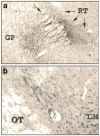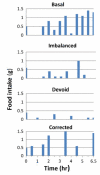The brain's response to an essential amino acid-deficient diet and the circuitous route to a better meal
- PMID: 22674217
- PMCID: PMC3469761
- DOI: 10.1007/s12035-012-8283-8
The brain's response to an essential amino acid-deficient diet and the circuitous route to a better meal
Abstract
The essential (indispensable) amino acids (IAA) are neither synthesized nor stored in metazoans, yet they are the building blocks of protein. Survival depends on availability of these protein precursors, which must be obtained in the diet; it follows that food selection is critical for IAA homeostasis. If even one of the IAA is depleted, its tRNA becomes quickly deacylated and the levels of charged tRNA fall, leading to disruption of global protein synthesis. As they have priority in the diet, second only to energy, the missing IAA must be restored promptly or protein catabolism ensues. Animals detect and reject an IAA-deficient meal in 20 min, but how? Here, we review the molecular basis for sensing IAA depletion and repletion in the brain's IAA chemosensor, the anterior piriform cortex (APC). As animals stop eating an IAA-deficient meal, they display foraging and altered choice behaviors, to improve their chances of encountering a better food. Within 2 h, sensory cues are associated with IAA depletion or repletion, leading to learned aversions and preferences that support better food selection. We show neural projections from the APC to appetitive and consummatory motor control centers, and to hedonic, motivational brain areas that reinforce these adaptive behaviors.
Figures





Similar articles
-
Mechanisms of food intake repression in indispensable amino acid deficiency.Annu Rev Nutr. 2007;27:63-78. doi: 10.1146/annurev.nutr.27.061406.093726. Annu Rev Nutr. 2007. PMID: 17328672 Review.
-
Effects of essential amino acid deficiency: down-regulation of KCC2 and the GABAA receptor; disinhibition in the anterior piriform cortex.J Neurochem. 2013 Nov;127(4):520-30. doi: 10.1111/jnc.12403. Epub 2013 Sep 12. J Neurochem. 2013. PMID: 24024616 Free PMC article.
-
The anterior piriform cortex is sufficient for detecting depletion of an indispensable amino acid, showing independent cortical sensory function.J Neurosci. 2011 Feb 2;31(5):1583-90. doi: 10.1523/JNEUROSCI.4934-10.2011. J Neurosci. 2011. PMID: 21289166 Free PMC article.
-
Uncharged tRNA and sensing of amino acid deficiency in mammalian piriform cortex.Science. 2005 Mar 18;307(5716):1776-8. doi: 10.1126/science.1104882. Science. 2005. PMID: 15774759
-
Nutritional homeostasis and indispensable amino acid sensing: a new solution to an old puzzle.Trends Neurosci. 2006 Feb;29(2):91-9. doi: 10.1016/j.tins.2005.12.007. Epub 2006 Jan 10. Trends Neurosci. 2006. PMID: 16406138 Review.
Cited by
-
Amino acid homeostasis and signalling in mammalian cells and organisms.Biochem J. 2017 May 25;474(12):1935-1963. doi: 10.1042/BCJ20160822. Biochem J. 2017. PMID: 28546457 Free PMC article. Review.
-
Leucine deprivation results in antidepressant effects via GCN2 in AgRP neurons.Life Metab. 2023 Feb 4;2(1):load004. doi: 10.1093/lifemeta/load004. eCollection 2023 Feb. Life Metab. 2023. PMID: 39872511 Free PMC article.
-
Central Amino Acid Sensing in the Control of Feeding Behavior.Front Endocrinol (Lausanne). 2016 Nov 23;7:148. doi: 10.3389/fendo.2016.00148. eCollection 2016. Front Endocrinol (Lausanne). 2016. PMID: 27933033 Free PMC article. Review.
-
Lysine Deprivation Regulates Npy Expression via GCN2 Signaling Pathway in Mandarin Fish (Siniperca chuatsi).Int J Mol Sci. 2022 Jun 16;23(12):6727. doi: 10.3390/ijms23126727. Int J Mol Sci. 2022. PMID: 35743178 Free PMC article.
-
Amino acid supplementation counteracts negative effects of low protein diets on tail biting in pigs more than extra environmental enrichment.Sci Rep. 2023 Nov 7;13(1):19268. doi: 10.1038/s41598-023-45704-0. Sci Rep. 2023. PMID: 37935708 Free PMC article.
References
-
- Geiger E. Experiments with delayed supplementation of incomplete amino acid mixtures. J Nutr. 1947;34(1):97–111. - PubMed
-
- Peters JC, Harper AE. Influence of dietary protein level on protein self-selection and plasma and brain amino acid concentrations. Physiol Behav. 1984;33(5):783–790. - PubMed
-
- Sorensen A, Mayntz D, Raubenheimer D, Simpson SJ. Protein-leverage in mice: the geometry of macronutrient balancing and consequences for fat deposition. Obesity (Silver Spring) 2008;16(3):566–571. doi:10.1038/oby.2007.58. - PubMed
-
- Tome D. Protein, amino acids and the control of food intake. Br J Nutr. 2004;92(Suppl 1):S27–S30. - PubMed
-
- Harper AE, Benevenga NJ, Wohlhueter RM. Effects of ingestion of disproportionate amounts of amino acids. Physiol Rev. 1970;50(3):428–558. - PubMed
Publication types
MeSH terms
Substances
Grants and funding
LinkOut - more resources
Full Text Sources
Research Materials

